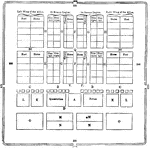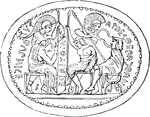
Morgan Dix
(1827-1908) American author that wrote works such as Commentaries on Romans and on Galatians and Colossians;…

Roman Military Chariot
A vehicle used for pleasure and war by the early Assyrians, Egyptians, Greeks, and Romans. The vehicle…
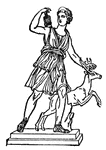
Diana
Diana was a goddess of the Romans. She was the daughter of Zeus and Leto, twin sister of Apollo, and…
!["The Pen-Fish or Common Calamary, <em>L. vulgaris</em>, is the best-known species of the genus; the body is somewhat pellucid, of a greenish hue, changeable to dirty brown; the eyes are large and lustrous, of an emerald green, phosphoric, and fiery in a high degree. It is common in the european seas, and was known to the ancient Greeks and Romans. [Shown with a quill pen]" — Goodrich, 1859](https://etc.usf.edu/clipart/14000/14004/cmncalamari_14004_mth.gif)
Common calamari
"The Pen-Fish or Common Calamary, L. vulgaris, is the best-known species of the genus; the…

Pompey
"Pompey was one of the men, who, having distinguished himself in foreign wars, was looked upon as the…
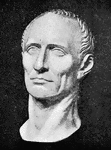
Caesar
"Julius Caesar was the leader of the popular party, who in a few years was destined to prove himself…

Germans
"Early Germans. These German ancestors of ours, for so we must consider them, since the chief element…
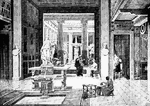
House
"A Roman house. In early times the private houses of the Romans were very simple, showing little attempt…

Aphrodite
"The Greek goddess of love and beauty, identified by the Romans with their Venus, who was originally…
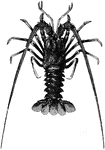
Spiny lobster
"The Spiny Lobster, Palinurus vulgaris, which may be taken as the type of the family, often…
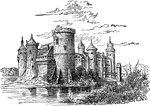
Castle
"A Castle is a building constructed for the purpose of repelling attack. The castella left by the Romans…
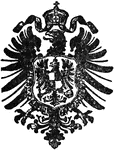
German Eagle
"The Eagle is an emblem in heraldry, war, and legend. The eagle, borne upon a spear, was used by the…
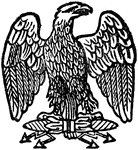
French Eagle
"The Eagle is an emblem in heraldry, war, and legend. The eagle, borne upon a spear, was used by the…

Football Field at Kick-Off
"Football is a field game played in the United States, Great Britain, Canada, and Australia. The game…

Football Field at Scrimmage
"Football is a field game played in the United States, Great Britain, Canada, and Australia. The game…
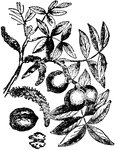
Walnut
"Walnut is a genus comprising seven or eight species of beautiful trees. The common walnut is a native…

Auger
"Among the anceient Romans, a functionary whose duty it was to observe and to interpret, according to…
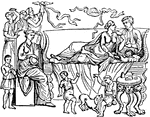
Accubatio
"The act of reclining at meals. The Greeks and Romans were accustomed, in later times, to recline at…

Acinaces
"A Persian sword, whence Horace speaks of the Medus acinaces. The acinaces was a short and…

Amphorae
"A vessel used for holding wine, oil, honey. The following cut represents amphorae in the British Museum.…
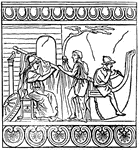
Antefixa
"Antefixa representing Minerva superintending the construction of the Ship Argo. Antefixa are terra-cottas,…
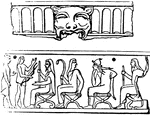
Antefixa
"The two imperfect antefixa, are amoung those found at Velletri, and described by Carloni. Antefixa…

Aratrum
"A plough. Among the Greek and Romans the three most essential parts of the plough were-the plough tail,…

Aratrum
"A plough. Among the Greek and Romans the three most essential parts of the plough were-the plough tail,…

Balneum
"Balneum or balineum signifies, in its primary sense, a bath or bathing vessel, such as most Romans…

Balneum
"Balneum or balineum signifies, in its primary sense, a bath or bathing vessel, such as most Romans…

Bracae
"Trowsers, pantaloons, were common to all the nations which encircled the Greek and Roman population,…
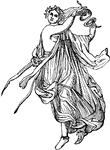
Calceus
"A shoe or boot, anything adapted to cover and preserve the feet in walking. The use of shoes was by…

Calceus
"A shoe or boot, anything adapted to cover and preserve the feet in walking. The use of shoes was by…
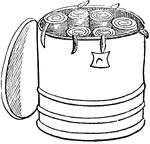
Capsa
"A box for holding books among the Romans. These boxes were of cylindrical form. There does not appear…

Roman galley
"Elated by the victory, the Romans now determined to drive Carthage out of the island altogether. This,…

Cardo
A hinge or pivot. The first figure, in the annexed woodcut, is designed to show the general form of…

Chirodota
"A tunic with sleeves. The tunic of the Egyptians, Greeks and Romans was originally without sleeves,…
Clavis
"A key. The key was used in very early times, and was probably introduced into Greece from Egypt; although…

Clipeus
"The large shield worn by the Greeks and Romans, which was originally of the circular form, and is said…
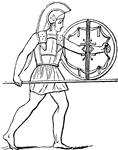
Clipeus
"The large shield worn by the Greeks and Romans, which was originally of the circular form, and is said…
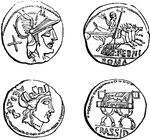
Denarius
"The principal silver coin among the Romans, was so called because it was originally equal to ten asses;…

Focus
"A fire-place; a hearth; a brazier. The fire-place possessed a sacred character, and was dedicated among…

Roman hinges
"The Greeks and Romans used hinges exactly like those now in common use. The following cut exhibits…
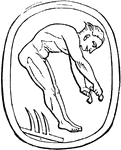
Halteres
"Halteres were certain masses of stone or metal, which were used in the gymnastic exercises of the Greeks…

Lectica
"Lectica was a kind of couch or litter, in which persons, in a lying position, were carried from one…

Lectisternium
"Sacrifices being of the nature of feasts, the Greeks and Romans, on occasion of extraordinary solemnities,…

Liber
"The most common material on which books were written by the Greeks and Romans, was the thin coats or…

Lorica
"A cuirass. The cuirass was worn by the heavy-armed infantry both among the Greeks and Romans. The soldiers…

Lorica
"A cuirass. The cuirass was worn by the heavy-armed infantry both among the Greeks and Romans. The soldiers…

Lucerna
"An oil lamp. The Greeks and Romans originally used candles; but in later times candles were chiefly…
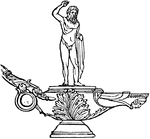
Lucerna
"An oil lamp. The Greeks and Romans originally used candles; but in later times candles were chiefly…

Paenula
"A thick cloak, cheifly used by the Romans in traveling, instead of the toga, as a protection against…
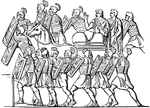
Hollow Square
Military formation of the Romans, also agmen quadratum. Square formation with no troops in the middle.

Pileus
"Any piece of felt; more especially, a skull-cap of felt, a hat. These seems no reason to doubt that…
Pons Cestius
"A bridge. As the rivers of Greece were small, and the use of the arch known to them only to a limited…

Pons Aelius
"A bridge. As the rivers of Greece were small, and the use of the arch known to them only to a limited…
Pons Ariminum
"A bridge. As the rivers of Greece were small, and the use of the arch known to them only to a limited…
Pons Trajan
"A bridge. As the rivers of Greece were small, and the use of the arch known to them only to a limited…

Salatio
"Dancing. The dancing of the Greeks as well as of the Romans had very little in common with the exercise…
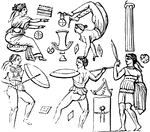
Salatio
"Dancing. The dancing of the Greeks as well as of the Romans had very little in common with the exercise…
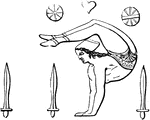
Salatio
"Dancing. The dancing of the Greeks as well as of the Romans had very little in common with the exercise…

